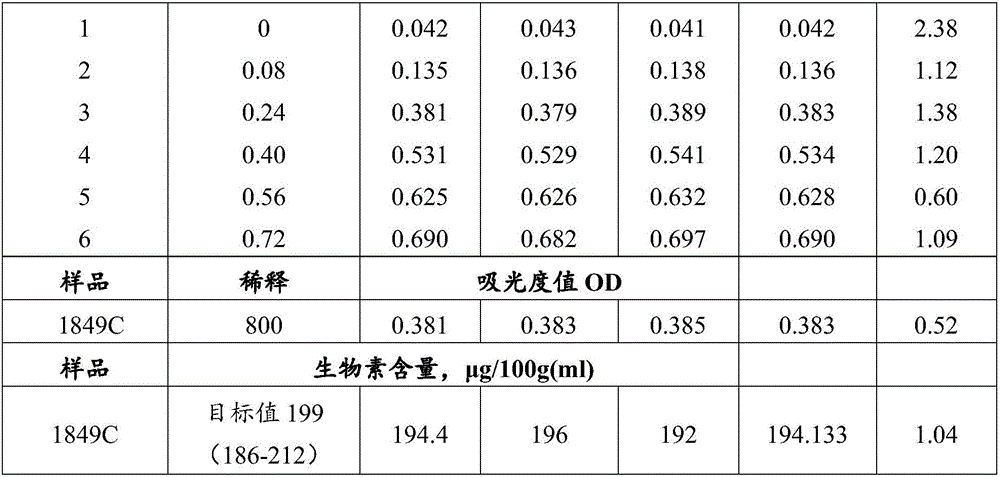Microwell plate for quantitatively detecting biotin with microbiological method, kit containing microwell plate and preparation method of microwell plate
A biotin and microplate technology, applied in the field of microplates, can solve the problems of strain loss, wrong results, high detection background, etc., and achieve the effect of improving accuracy and reducing strain loss.
- Summary
- Abstract
- Description
- Claims
- Application Information
AI Technical Summary
Problems solved by technology
Method used
Image
Examples
Embodiment 1
[0053] 1. Microplate Preparation
[0054] (1) Activated Lactobacillus plantarum ATCC 8014
[0055] Add 11g of skimmed milk powder to 89ml of distilled water, mix well, dispense into test tubes in units of 10ml, and sterilize at 115°C for 15 minutes. This solution is a liquid medium.
[0056] Add 0.3g of powdered Lactobacillus plantarum ATCC 8014 strain into 10ml of medium, culture at 37±1°C until curdling, and store in the refrigerator at 4°C.
[0057] Add 0.3ml of the cultured bacteria in the above step to 10ml of culture medium, and cultivate at 37±1°C until curdling.
[0058] Repeat the previous step several times until the curd time is stable, indicating that the bacteria have been activated.
[0059] (2) Preparation of test bacteria solution
[0060] Inoculate the activated Lactobacillus plantarum ATCC 8014 strain into the Lactobacillus broth medium, culture at 36°C±1°C for 24h, centrifuge at 2100 rpm for 2min, stop the cultivation, and discard the supernatant;
[006...
Embodiment 2
[0074] 1. Microplate Preparation
[0075] Lactobacillus plantarum ATCC 8014 was used as the coated Lactobacillus plantarum strain, and the steps were as follows: Inoculate the activated bacterial strain (the activation treatment method is the same as in Example 1) into the Lactobacillus broth medium, cultivate it at 38°C ± 1°C for 18h, and inoculate it at 2100°C. Centrifuge at rpm for 3 min to stop the culture and discard the supernatant. Add 197mM sucrose and 9mM CaCl 2 12ml of protective agent mixture, mix well, and then centrifuge for 2min, discard the supernatant, add 12ml of protective agent, mix well. Centrifuge as before and discard the supernatant. Add 10ml of protective agent and mix well. Aspirate 2ml of the bacterial suspension into 12ml of protective agent, mix well to make the test bacterial liquid.
[0076] Add 1 μl of the bacterial solution to each well of the microwell plate, and heat the bacterial solution slightly under the low vacuum environment of 26mTo...
experiment example 1
[0088] This experimental example is to study the precision of the kit of the present invention.
[0089] Use 3 batches of kits (kits prepared in Example 1) to detect National Institute of Standards and Technology milk powder reference substance 1849C (biotin concentration is 199 μg / 100g)], do parallel experiments, the results are shown in Table 1. 1 dilution of milk powder reference substance 1849C was tested per batch (final concentration within the range of the standard curve).
[0090] Table 1
[0091]
[0092]
[0093] The coefficient of variation (1.04%) for determining the concentration of milk powder reference substance is very small, indicating high precision. The variation in the raw results of the standards among the 3 batches was less than 10%.
[0094] Use 3 batches of kits (kits prepared in Example 2) to detect milk powder reference substance 1849C [National Institute of Standards and Technology milk powder reference substance, concentration target value i...
PUM
 Login to View More
Login to View More Abstract
Description
Claims
Application Information
 Login to View More
Login to View More - R&D
- Intellectual Property
- Life Sciences
- Materials
- Tech Scout
- Unparalleled Data Quality
- Higher Quality Content
- 60% Fewer Hallucinations
Browse by: Latest US Patents, China's latest patents, Technical Efficacy Thesaurus, Application Domain, Technology Topic, Popular Technical Reports.
© 2025 PatSnap. All rights reserved.Legal|Privacy policy|Modern Slavery Act Transparency Statement|Sitemap|About US| Contact US: help@patsnap.com



